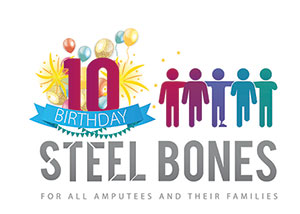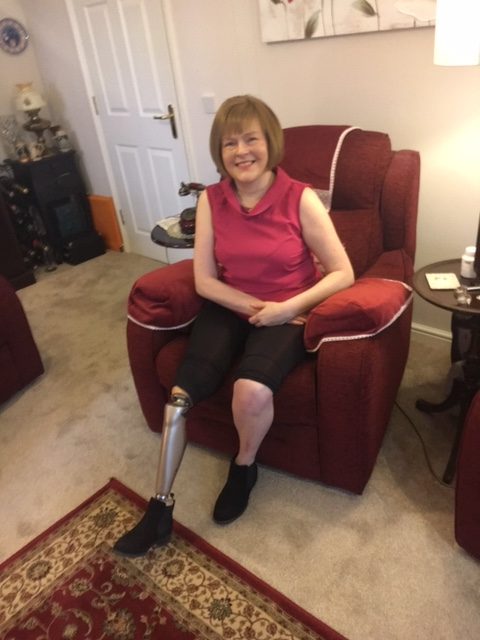This blog is taken from the Ottobock site which features Debbie’s story but we wanted to feature it as it is such an amazing triumph of determination, perseverance and knowing what’s best for you. Take a read below and click onto the Ottobock website to watch the video: https://www.ottobock.co.uk/prosthetics/real-life-stories/debbie’s-c-leg-story/
Amputee starts new career thanks to advanced prosthetic leg
Following the amputation of her leg over five years ago, Debbie was determined to return to the active lifestyle she previously enjoyed. Looking for something more suitable than the basic prosthesis she was originally given, she started a campaign to get an advanced prosthetic leg, the C-Leg 4. At the time it was only available through private clinics until a new NHS fund for microprocessor-controlled knees was made available in early 2017. Here, she explains how this state-of-the-art prosthesis has led her to reclaim not only her independence but her identity too.
In 2012, an infection in Debbie’s right foot led to multiple surgeries and four months of poor health, ultimately resulting in the amputation of her right leg. At first she didn’t know what to expect or how she would cope following her operation, as well as feeling that she lost her independence when she had to move back in with her parents. “That was a difficult transition as I was used to following my own schedule and having my own space. It was so stressful and none of us could believe that I had lost my leg,” she says. After six weeks, she moved back into her own home again, getting around without the use of a prosthetic limb to support her mobility. She found everyday activities extremely challenging; if she needed to go upstairs she would have to pull herself up and down in a seated position. Unsurprisingly, Debbie ended up spending most of her time on the ground floor of her house using a wheelchair. Despite the fact that her life had changed in ways she could never have imagined, Debbie resolved to try her best to return to the independent lifestyle she had previously enjoyed so much, saying; “Even though it was so difficult, I decided that after everything that had happened, I had to make sure it would all be OK in the end.”
When the time came for Debbie to begin using a prosthesis she found that she also had to learn how to walk again. “Learning how to walk again is very hard. When it’s shown on TV they make it look so easy but the problem is that you worry about tripping or stumbling, and it’s so different to what it’s like with two legs” she says. The mechanical knee that she was given gave her the chance to regain some of her mobility, but she found movement incredibly difficult and suffered from a fear of falling. “It’s hard to put your trust in a mechanical knee. It can fold up underneath you when you’re not expecting it and you end up falling over. I started to get really scared of getting hurt and I would avoid going out sometimes,” adds Debbie.
Nonetheless, Debbie retained her determination and even managed to return to her job in the social care sector just five months after her operation; “When I woke up in critical care after my amputation I knew from the beginning that I wanted to go back to work and live independently because that’s what I’ve done for so many years.” She explains that it took patience for her to try to return to some level of normality; “every day I woke up not knowing what to expect and not knowing what was coming. It’s one of those things you hope you never have to go through.” She used mobility aids including walking sticks, but she never lost sight of her ambition to walk confidently.
Due to Debbie’s tenacity and resolve to keep active, her Prosthetist suggested that it would be worthwhile to consider a more advanced prosthetic solution such as Ottobock’s C-Leg. He suggested that its stability and functionality would help her to feel more confident, and less at risk of falling. At this time, the C-Leg was only available via private sources of funding. Unsure that she would be able to secure the funds in the long term, Debbie decided to continue with her more basic prosthesis. She continued to research into the C-Leg and the more she learned, the more she wanted to try it out, saying, “I googled “C-Leg” and saw videos of people walking, I thought it looked amazing, so natural and so much easier than what I was going through.” A year later, Debbie started a campaign to try to receive a C-Leg via NHS funding, even writing to the Prime Minister, the Health Minister and her local MP explaining the impact that the C-Leg would have on her life. “I fought for the C-Leg because I knew that was what I needed. I wrote to everybody explaining that because I wanted to work and have a good job, a C-Leg would make my life so much better.” After her attempts proved unsuccessful, Debbie took a break from her battle for a C-Leg, feeling exhausted.
Just 18 months later, Debbie received an email from her Prosthetist that would change her life. The C-Leg that she had long wished for was now available on the NHS. “I couldn’t believe that this could actually happen, it was incredible. I phoned the limb centre just to double check it was true!”
Debbie bought her family along with her when she was finally fitted with her C-Leg 4. They couldn’t believe their eyes when they saw her walk again. After some physiotherapy, Debbie was walking with confidence and stability. Her goal now is to get fitter in order to make the most of the opportunities that the C-Leg has opened up to her. “I’m still amazed that it has made me feel like the Debbie I used to be. When you lose a limb you start to feel like you’re losing your identity and now I am getting it back.” On the very first day after her fitting, she walked into the supermarket without the support of her walking stick, and couldn’t believe how much better her gait had become already. She explains that her limb centre played a crucial role in giving her back her sense of self; “I can’t thank the team at Norwich enough. They were so helpful and supportive, and I really am grateful.”
Five years on from her amputation, Debbie has left her previous job so that she can devote herself to studying for a professional qualification in counselling. Her ambition is to become a counsellor, specialising in supporting other amputees. “After my amputation I was very focused on my goals of getting back to work and walking confidently. These goals kept me going through the hard times and now I am in a position where I hope I can help other amputees who have been through something similar.” She goes to the gym as a way of improving her fitness to make the most of the opportunities offered by the C-Leg. She is also spreading the word about MPK funding through the NHS, making sure that the friends she has met through her limb centre are aware of how life-changing the C-Leg can be.
A Microprocessor Controlled Knee (MPK) is a form of advanced prosthesis designed to help above knee amputees walk with a much more stable and efficient gait whilst reducing the chance of stumbles and falls. Launched in 2015, Ottobock’s C-Leg 4 has a complex sensor system that captures data in real time and recognises which phase of walking the user is in. It adapts to the user’s natural gait pattern, even at various speeds, whether on level ground, going down stairs step-over-step, backwards or on slopes. The user will be able to navigate difficult surfaces and the unique stumble recovery function helps them to build confidence.
More than 40 clinical research studies have shown the effectiveness of the C-Leg in providing outcomes that improve daily life, including:
- Significantly reduced falls
- Increased activity levels
- A wider range of movement
- Fewer distractions since attention isn’t focused on avoiding obstacles
- Enhanced confidence in the prosthesis
- Reduced energy expenditure



Recent Comments